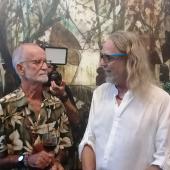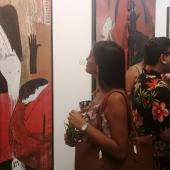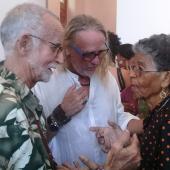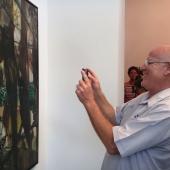Finale Worlds
Description:
Palabras del catálogo
Moisés Finalé's various journeys around the planet have served him well to nurture his talent and imagination, as well as his countless readings and the enjoyment of multiple expressions of art and culture.
In a kind of anthropophagic will, he assimilates and digests everything, devours everything with sensitivity and passion, and does not discriminate what his eyes see because for him everything becomes nutritious substance to encourage his creation, since in 1981 he exhibits his first works to the public in a modest space of the National Museum of Fine Arts. Since then it has been characterized by a singular, unique guración fi, which we recognize as our (Cuban, Caribbean and universal) to feel the influjo of the many cultural sources that give credibility to it.
For Finalé, what has been created by man and nature has an unquestionable value, a raison d'être that we should not overlook. Member of a generation that redimensioned the simplicity and authenticity of the popular, the vernacular, the different facets of Catholic and African religiosity, the cult and academic, in the 1980s in Cuba, translated these and other loves into a work began to spread along unknown paths of the two-dimensional until in 1995 decides to explore the virtues of the three-dimensional, objects and major scales for creation. Since then he has not stopped. When one least imagines it, he adds sequins and embroideries on the limits of canvases, or furniture filling material in the form of soft sculptures, or refunctionalizes plastic cubes, knives, fabrics, screws, remains of aged wood as the most natural thing in the world.
Thus he makes us aware of the delirium of creation, without paying too much attention to the goodness or exquisiteness of the materials: everything is valid, he tells us, to feed the fire of imagination. He quietly creates a personal work that distinguishes him within the panorama of contemporary Cuban art. His composition and figuración assume the legacy of Cuban masters (Lam, Girona, A. Cárdenas, Jesús G. de Armas) and of other latitudes (De Kooning, Bacon) as well as of ancestral African cultures (Dogon sculpture, bambará in the continental west), of the Middle East (Egypt, Syria, ancient Mesopotamia), of Asia (India, Japan) and it comes to mind as soon as we stop to observe the whole or parts of one of his works.
He finds in France the fifth leg of a table that he does not hide and to which he renders devotion in his conversations and feelings. It is not for less because there he spent several years of his life while flying towards near countries, dazzled by his visualities until settling defi nitivamente in an old house of El Vedado of republican, eclectic and colonial airs, whose floors of mosaics and marble and plaster details brighten the gaze of his and of any visitor.
His intellectual life is distributed, then, in diverse hemispheres, either traveling physically or mentally (like Lezama Lima) through so many regions of the planet. Many worlds nest in his head. His compass is oriented towards an aesthetic arising from the natural encounter of cultures, without trauma, domination or vassalage. He does not investigate social criticism, irony, cynicism and humour, so common in difficult times. He bets better on the emergence of a morphology that synthesizes the aesthetic plurality we live regardless of its origin: it is therefore democratic, open, free as they say the wind is. It reveals to us, of course, certain theatricalities of human behavior through the use of masks and disguises, as well as the eroticism that underlies our daily relationships.
That is why so much mixture, so much hybridity and crossbreeding make it, fin and in the end, the other way round and right, an exemplary Cuban and Caribbean creator. Unaware of fashion trends, of the demolishing impulses of the market, Finalé builds a varied universe of artistic proposals in which the materials used appear without shavings or delicacies. Hence its high degree of honesty and frankness.
That's why I congratulate Maxima Gallery (in its glass border between modern and old Havana) on assuming this peculiar exhibition that acts as a synthesis of his work. The public around there will be able to appreciate it as we do as we enter their space. Finalé offers us an extensive and dilated cultural vision of art. A whole world concentrated in several that we cannot ignore.
Nelson Herrera Ysla
Inauguration of the exhibition Finale Worlds de Moisés Finalé, open to the public from 27 September to 27 October 2019.










